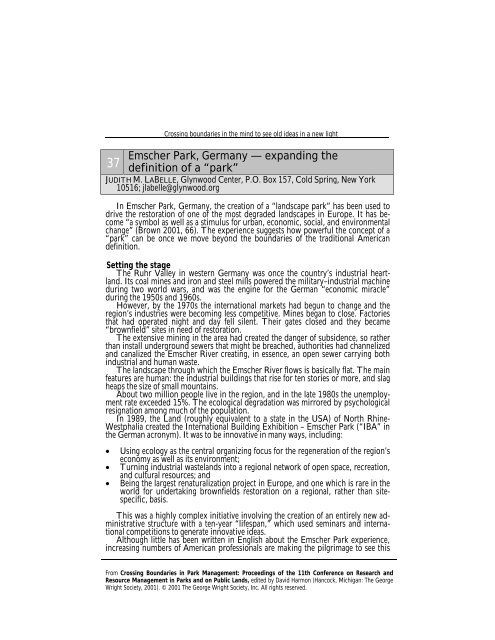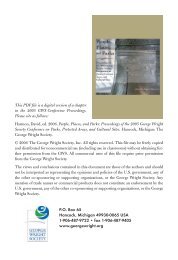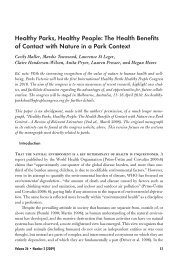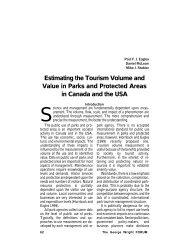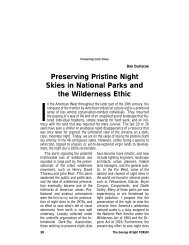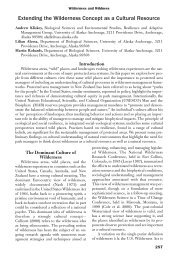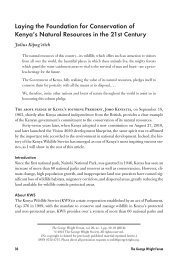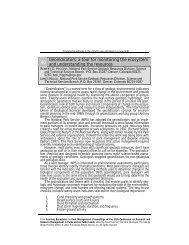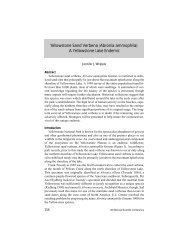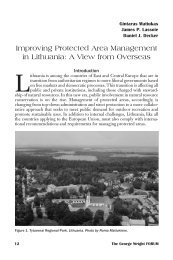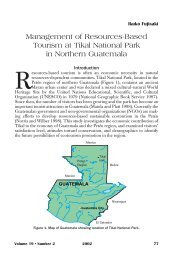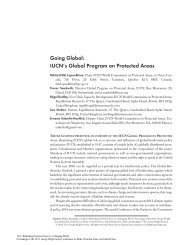Emscher Park, Germany — expanding the definition of a “park”
Emscher Park, Germany — expanding the definition of a “park”
Emscher Park, Germany — expanding the definition of a “park”
Create successful ePaper yourself
Turn your PDF publications into a flip-book with our unique Google optimized e-Paper software.
37<br />
Crossing boundaries in <strong>the</strong> mind to see old ideas in a new light<br />
<strong>Emscher</strong> <strong>Park</strong>, <strong>Germany</strong> <strong>—</strong> <strong>expanding</strong> <strong>the</strong><br />
<strong>definition</strong> <strong>of</strong> a <strong>“park”</strong><br />
JUDITH M. LABELLE, Glynwood Center, P.O. Box 157, Cold Spring, New York<br />
10516; jlabelle@glynwood.org<br />
In <strong>Emscher</strong> <strong>Park</strong>, <strong>Germany</strong>, <strong>the</strong> creation <strong>of</strong> a “landscape park” has been used to<br />
drive <strong>the</strong> restoration <strong>of</strong> one <strong>of</strong> <strong>the</strong> most degraded landscapes in Europe. It has become<br />
“a symbol as well as a stimulus for urban, economic, social, and environmental<br />
change” (Brown 2001, 66). The experience suggests how powerful <strong>the</strong> concept <strong>of</strong> a<br />
<strong>“park”</strong> can be once we move beyond <strong>the</strong> boundaries <strong>of</strong> <strong>the</strong> traditional American<br />
<strong>definition</strong>.<br />
Setting <strong>the</strong> stage<br />
The Ruhr Valley in western <strong>Germany</strong> was once <strong>the</strong> country’s industrial heartland.<br />
Its coal mines and iron and steel mills powered <strong>the</strong> military–industrial machine<br />
during two world wars, and was <strong>the</strong> engine for <strong>the</strong> German “economic miracle”<br />
during <strong>the</strong> 1950s and 1960s.<br />
However, by <strong>the</strong> 1970s <strong>the</strong> international markets had begun to change and <strong>the</strong><br />
region’s industries were becoming less competitive. Mines began to close. Factories<br />
that had operated night and day fell silent. Their gates closed and <strong>the</strong>y became<br />
“brownfield” sites in need <strong>of</strong> restoration.<br />
The extensive mining in <strong>the</strong> area had created <strong>the</strong> danger <strong>of</strong> subsidence, so ra<strong>the</strong>r<br />
than install underground sewers that might be breached, authorities had channelized<br />
and canalized <strong>the</strong> <strong>Emscher</strong> River creating, in essence, an open sewer carrying both<br />
industrial and human waste.<br />
The landscape through which <strong>the</strong> <strong>Emscher</strong> River flows is basically flat. The main<br />
features are human: <strong>the</strong> industrial buildings that rise for ten stories or more, and slag<br />
heaps <strong>the</strong> size <strong>of</strong> small mountains.<br />
About two million people live in <strong>the</strong> region, and in <strong>the</strong> late 1980s <strong>the</strong> unemployment<br />
rate exceeded 15%. The ecological degradation was mirrored by psychological<br />
resignation among much <strong>of</strong> <strong>the</strong> population.<br />
In 1989, <strong>the</strong> Land (roughly equivalent to a state in <strong>the</strong> USA) <strong>of</strong> North Rhine-<br />
Westphalia created <strong>the</strong> International Building Exhibition – <strong>Emscher</strong> <strong>Park</strong> (“IBA” in<br />
<strong>the</strong> German acronym). It was to be innovative in many ways, including:<br />
• Using ecology as <strong>the</strong> central organizing focus for <strong>the</strong> regeneration <strong>of</strong> <strong>the</strong> region’s<br />
economy as well as its environment;<br />
• Turning industrial wastelands into a regional network <strong>of</strong> open space, recreation,<br />
and cultural resources; and<br />
• Being <strong>the</strong> largest renaturalization project in Europe, and one which is rare in <strong>the</strong><br />
world for undertaking brownfields restoration on a regional, ra<strong>the</strong>r than sitespecific,<br />
basis.<br />
This was a highly complex initiative involving <strong>the</strong> creation <strong>of</strong> an entirely new administrative<br />
structure with a ten-year “lifespan,” which used seminars and international<br />
competitions to generate innovative ideas.<br />
Although little has been written in English about <strong>the</strong> <strong>Emscher</strong> <strong>Park</strong> experience,<br />
increasing numbers <strong>of</strong> American pr<strong>of</strong>essionals are making <strong>the</strong> pilgrimage to see this<br />
From Crossing Boundaries in <strong>Park</strong> Management: Proceedings <strong>of</strong> <strong>the</strong> 11th Conference on Research and<br />
Resource Management in <strong>Park</strong>s and on Public Lands, edited by David Harmon (Hancock, Michigan: The George<br />
Wright Society, 2001). © 2001 The George Wright Society, Inc. All rights reserved.
Crossing boundaries in <strong>the</strong> mind to see old ideas in a new light<br />
project for <strong>the</strong>mselves. Given <strong>the</strong> scope, complexity and unusual nature <strong>of</strong> <strong>the</strong> project,<br />
it is not surprising that most <strong>of</strong> us have only scratched <strong>the</strong> surface<strong>—</strong>and each <strong>of</strong><br />
us has seen <strong>the</strong> project through our own prism. Never<strong>the</strong>less, I would like to focus<br />
on a few main ideas that relate to <strong>the</strong> special interests <strong>of</strong> <strong>the</strong> George Wright Society<br />
and <strong>the</strong> conference <strong>the</strong>me <strong>of</strong> “Crossing Boundaries”:<br />
• The power <strong>of</strong> ecology as a central focus and integrating concept for a regional<br />
redevelopment initiative;<br />
• The impact <strong>of</strong> using art in <strong>the</strong> landscape to signal a new policy approach; and<br />
• How <strong>the</strong> creative re-use <strong>of</strong> industrial buildings can play a powerful role in<br />
changing <strong>the</strong> mind-set <strong>of</strong> local residents. This may have been <strong>Emscher</strong> <strong>Park</strong>’s<br />
most impressive accomplishment.<br />
The power <strong>of</strong> ecology as an integrating concept<br />
Within <strong>the</strong> Ruhr region, <strong>the</strong> IBA focused on <strong>the</strong> <strong>Emscher</strong> River which, with its<br />
tributaries, flows for about 218 miles. This shared resource provided a common focus<br />
for 17 local authorities in an area <strong>of</strong> approximately 200 square miles. A central<br />
aim <strong>of</strong> <strong>the</strong> project was to clean up <strong>the</strong> river. Now that mining has ended in much <strong>of</strong><br />
<strong>the</strong> region, underground sewers are being installed to carry waste, and <strong>the</strong> river is<br />
being renaturalized. The concrete channels are being removed and natural vegetation<br />
is being restored. This is important for water quality and management, and for habitat.<br />
Perhaps even more importantly, it provides a highly visible symbol <strong>of</strong> positive<br />
change.<br />
Ano<strong>the</strong>r central aim <strong>of</strong> <strong>the</strong> project was to integrate and develop existing open<br />
spaces to create a regional park system that would include seven green corridors<br />
running north–south and east–west through <strong>the</strong> region. The audacity <strong>of</strong> this plan<br />
becomes clear only when one realizes that <strong>the</strong> open space at <strong>the</strong> heart <strong>of</strong> this network<br />
comprises former industrial sites, <strong>the</strong>ir connecting transportation system, and <strong>the</strong> old<br />
slag heaps. This was to form <strong>the</strong> basis for a park system intended to be <strong>of</strong> “European<br />
significance.”<br />
Several <strong>the</strong>matic tourist driving and biking routes were created, including <strong>the</strong><br />
“Route <strong>of</strong> Industrial Culture” which includes routes with <strong>the</strong>mes such as <strong>the</strong> “Route<br />
<strong>of</strong> Industry and Nature.” These routes serve several purposes: to create and improve<br />
green infrastructure, provide more recreational opportunities, appeal to tourists, and<br />
increase <strong>the</strong> understanding <strong>of</strong> <strong>the</strong> region’s heritage among local residents as well as<br />
visitors.<br />
It is important to note that many <strong>of</strong> <strong>the</strong> sites that have become features <strong>of</strong> interest<br />
for both tourists and local residents were surrounded by residential areas, but that<br />
<strong>the</strong> residents were only allowed within <strong>the</strong> walls if <strong>the</strong>y worked <strong>the</strong>re. Many people<br />
had lived in <strong>the</strong> viewshed or within earshot <strong>of</strong> <strong>the</strong>se facilities all <strong>of</strong> <strong>the</strong>ir lives and<br />
never been on <strong>the</strong>ir grounds until <strong>the</strong> creation <strong>of</strong> <strong>the</strong> landscape park.<br />
The ecological <strong>the</strong>me was integrated into economic and residential development<br />
as well<strong>—</strong>with a pronounced emphasis on energy efficiency and, in particular, <strong>the</strong> use<br />
<strong>of</strong> solar technology. A prime example is found in Rheinelbe, where a stunning<br />
building, which incorporates state-<strong>of</strong>-<strong>the</strong>-art solar technology, serves as an incubator<br />
for new solar technology businesses. It is a beautiful space unto itself, but serves <strong>the</strong><br />
additional purpose <strong>of</strong> providing an internal walkway connecting <strong>the</strong> former colliery<br />
(which now has public open space and <strong>of</strong>fices) with <strong>the</strong> town.<br />
The Duisberg docklands, which have been falling into disuse as <strong>the</strong> industrial activity<br />
in <strong>the</strong> region declines, are also illustrative <strong>of</strong> this <strong>the</strong>me. A major urban redevelopment<br />
initiative has been undertaken with <strong>the</strong> goal <strong>of</strong> “bringing water back<br />
into <strong>the</strong> life <strong>of</strong> <strong>the</strong> city in an active way.” Among <strong>the</strong> ways this is being done are creating<br />
a multi-use urban waterfront, including energy-efficient <strong>of</strong>fices, creating side<br />
canals (with naturalized areas) as <strong>the</strong> site for new housing (Figure 37.1), and damming<br />
<strong>the</strong> canal to provide an area for swimming.<br />
in <strong>Park</strong>s and on Public Lands • The 2001 GWS Biennial Conference 223
Crossing boundaries in <strong>the</strong> mind to see old ideas in a new light<br />
Figure 37.1. New housing along newly created side canal in Duisberg. Photo by<br />
<strong>the</strong> author.<br />
Adaptive reuse <strong>of</strong> industrial buildings<br />
The region’s identity<strong>—</strong>historical, economic, and cultural<strong>—</strong>was associated with<br />
industrial plants, collieries, foundries, slag heaps, and <strong>the</strong> like. So immense efforts<br />
have been made to preserve and reuse <strong>the</strong>m as “industrial monuments.” It was important<br />
to help <strong>the</strong> local residents understand that <strong>the</strong> ecological devastation <strong>of</strong> <strong>the</strong><br />
region had been a function <strong>of</strong> a particular set <strong>of</strong> geographic, political, and economic<br />
forces, and that <strong>the</strong> people who had created and sustained <strong>the</strong>se industries were inventive,<br />
skilled, and strong. Ra<strong>the</strong>r than questioning <strong>the</strong> past, IBA challenged residents<br />
to consider how to use those valuable qualities to take <strong>the</strong> region into <strong>the</strong> new<br />
economy.<br />
A few examples <strong>of</strong> <strong>the</strong> manner in which industrial sites were reused will provide a<br />
sense <strong>of</strong> <strong>the</strong> inventive and imaginative power brought to bear by <strong>the</strong> IBA.<br />
The Oberhausen Gasometer, which had been used to store gas produced by<br />
nearby blast furnaces, closed in 1988. Over 385 feet in height and 220 feet in diameter,<br />
it has become Europe’s largest, and perhaps most unusual, exhibition space.<br />
224 Proceedings <strong>of</strong> <strong>the</strong> 11 th Conference on Research and Resource Management
Crossing boundaries in <strong>the</strong> mind to see old ideas in a new light<br />
An internal elevator allows visitors to see <strong>the</strong> interior <strong>of</strong> <strong>the</strong> space as <strong>the</strong>y ascend to<br />
<strong>the</strong> ro<strong>of</strong>, from which <strong>the</strong>y have a sweeping view <strong>of</strong> <strong>the</strong> entire area. The windows in<br />
<strong>the</strong> ceiling form a pattern not unlike <strong>the</strong> “rose window” <strong>of</strong> a ca<strong>the</strong>dral, and changeable<br />
colored panes are used to enhance <strong>the</strong> effect. Residents and visitors alike are<br />
awed by <strong>the</strong> scale and unexpected beauty <strong>of</strong> <strong>the</strong> interior <strong>of</strong> this behemoth.<br />
The Zollverein Colliery was actually known as <strong>the</strong> “ca<strong>the</strong>dral <strong>of</strong> labor.” One <strong>of</strong><br />
<strong>the</strong> most famous symbols <strong>of</strong> <strong>the</strong> mining industry in <strong>Germany</strong>, it closed in 1986. Its<br />
Bauhaus-inspired buildings have been adapted for many new cultural uses, including<br />
a museum <strong>of</strong> coal production, a center that features exhibitions <strong>of</strong> <strong>the</strong> best industrial<br />
design, a citizens’ center, and a fine restaurant. A solar-powered Ferris wheel carries<br />
visitors through part <strong>of</strong> <strong>the</strong> plant and high above it to catch <strong>the</strong> view. Hiking trails<br />
connect <strong>the</strong> Colliery to <strong>the</strong> nearby community.<br />
The Duisburg-Nord Industrial Landscape <strong>Park</strong> (landschaftspark Duisburg-Nord)<br />
contains well over 500 acres, most <strong>of</strong> it open space. Here visitors can explore a blast<br />
furnace, where one cannot help but be awed by <strong>the</strong> skill and strength demanded <strong>of</strong><br />
<strong>the</strong> men who once produced iron and steel here.<br />
But this is not a static monument. Imaginative steps have been taken to provide<br />
recreational uses that would entice visitors. Walls are used to provide rock-climbing<br />
lessons. A large metal tube curves out and down and back through a wall<strong>—</strong>becoming<br />
a slide provided for children (that attracts not a few adults as well; Figure 37.2).<br />
Figure 37.2. Children using slide in <strong>the</strong> Duisburg-Nord Industrial Landscape<br />
<strong>Park</strong>. Photos by Jennifer Petramale.<br />
Perhaps <strong>the</strong> oddest feature to a visitor is <strong>the</strong> multi-colored night lighting. However,<br />
<strong>the</strong>n one learns that <strong>the</strong> plants had been operational 24 hours per day<strong>—</strong>and<br />
when <strong>the</strong>y closed, residents said “it was as though <strong>the</strong> night sky had died.” This new<br />
lighting, created as a result <strong>of</strong> an international design competition, was not intended<br />
to replicate <strong>the</strong> old. Ra<strong>the</strong>r it is ano<strong>the</strong>r example <strong>of</strong> <strong>the</strong> ways in which <strong>Emscher</strong> <strong>Park</strong><br />
in <strong>Park</strong>s and on Public Lands • The 2001 GWS Biennial Conference 225
Crossing boundaries in <strong>the</strong> mind to see old ideas in a new light<br />
helps bring <strong>the</strong> past through <strong>the</strong> present into <strong>the</strong> future. It is also an example <strong>of</strong> <strong>the</strong><br />
project’s innovative use <strong>of</strong> art.<br />
Use <strong>of</strong> art in <strong>the</strong> landscape<br />
The IBA conducted several international competitions to select art to be placed in<br />
<strong>the</strong> landscape. This was not uncontroversial. Many people questioned whe<strong>the</strong>r <strong>the</strong><br />
money used to pay artists to design night lights for former industrial buildings or<br />
sculptures atop slag heaps might not be better spent for housing or o<strong>the</strong>r social<br />
needs.<br />
However, <strong>the</strong> art has helped to signal <strong>the</strong> forward-looking nature <strong>of</strong> <strong>the</strong> initiative<br />
and to provide a system <strong>of</strong> new landmarks through <strong>the</strong> landscape. Several large<br />
sculptures have been installed atop slag heaps, including <strong>the</strong> towering Tetrahedron<br />
at Bottrop (Figure 37.3). Lighted at night, <strong>the</strong>y provide new reference points in <strong>the</strong><br />
night landscape. Smaller, more intimate sculptures have been created in areas newly<br />
used for parks and recreation. They serve to draw <strong>the</strong> visitor into a landscape that<br />
had hi<strong>the</strong>rto been <strong>of</strong>f-limits and foreign. Some are composed <strong>of</strong> industrial artifacts<br />
found on <strong>the</strong> site, providing a more intimate connection with <strong>the</strong> site’s history.<br />
Figure 37.3. The Tetrahedron atop a slag heap in Bottrop, with active plants in<br />
<strong>the</strong> background. Photo by <strong>the</strong> author.<br />
226 Proceedings <strong>of</strong> <strong>the</strong> 11 th Conference on Research and Resource Management
Crossing boundaries in <strong>the</strong> mind to see old ideas in a new light<br />
This is consistent with ano<strong>the</strong>r underlying <strong>the</strong>me <strong>of</strong> <strong>the</strong> project: <strong>the</strong> importance <strong>of</strong><br />
building and site design, which are regarded as critical factors in <strong>the</strong> regeneration <strong>of</strong><br />
<strong>the</strong> economy and <strong>the</strong> environment. Examples abound, ranging from <strong>the</strong> former coal<br />
mine headquarters in Bottrop, which has been restored on <strong>the</strong> outside and redesigned<br />
on <strong>the</strong> inside to house a business incubator, to <strong>the</strong> bridges constructed<br />
throughout <strong>the</strong> region to provide pedestrian connections, each <strong>of</strong> which is innovative<br />
in terms <strong>of</strong> design and function.<br />
Summary<br />
In <strong>Emscher</strong> <strong>Park</strong>, <strong>the</strong> concept <strong>of</strong> a landscape park was used to drive <strong>the</strong> regeneration<br />
<strong>of</strong> a heavily degraded region. In so doing, it also helped to introduce residents to<br />
<strong>the</strong>ir culture in a new way. Many to whom we spoke felt that changing <strong>the</strong> mind-set<br />
<strong>of</strong> local residents was perhaps <strong>the</strong> IBA’s greatest accomplishment<strong>—</strong>particularly important<br />
during a time <strong>of</strong> economic restructuring. Now, we were told, residents are<br />
“aware, appreciative, and hopeful.”<br />
<strong>Emscher</strong> <strong>Park</strong> can help us expand our own sense <strong>of</strong> what is possible<strong>—</strong>and suggests<br />
<strong>the</strong> powerful potential <strong>of</strong> new concepts <strong>of</strong> “parks.”<br />
Reference<br />
Brown, Brenda J. 2001. Reconstructing <strong>the</strong> Ruhrgebiet. Landscape Architecture<br />
4/2001, 66.<br />
in <strong>Park</strong>s and on Public Lands • The 2001 GWS Biennial Conference 227


